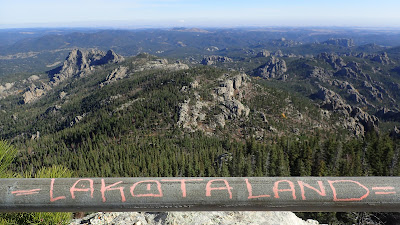I wanted to get out and do some exploring today, but the weather was forecast to be a bit iffy in Colorado. Instead of making a long drive, I opted to stay closer to home to hike the portion of the route of the Oregon/California Trail that passes through Scotts Bluff National Monument. I made the short drive out to the monument and parked at the east entrance. I followed the boundary fence a short distance south and quickly picked found the first trail marker.
would follow similar trail markers through the rest of the monument.
As I traveled west it was obvious that fall is coming to a close and that winter will soon be here. Frost coated some of the grasses and shrubs that I traveled past.
Once I had left the site of William Henry Jackson's 1866 campsite, the hiking became more difficult. I would look back every now and then to check out the view behind me.
The trail was easy to follow in some areas. In other areas, I lost it completely. Towards the western boundary of the monument, I got completely off trail. I followed the boundary fence north and finally found the western-most trail marker in the monument.
From here the trail continued west northwest towards the North Platte River and Fort Mitchell. All the land here is privately owned and so I would be headed back east.
Once back at the visitor center, I decided to hike the Prairie View Trail for something different.
As the Prairie View Trail dips into a ravine, I found an animal path that led to the canal road that leads to near the east entrance of the monument. There were some nice views from the road.
From the road I caught the last of the fall colors in the monument: a cottonwood tree in a ravine was covered with yellow-orange leaves.
Soon thereafter, I was back to my car and headed home for lunch.


















































